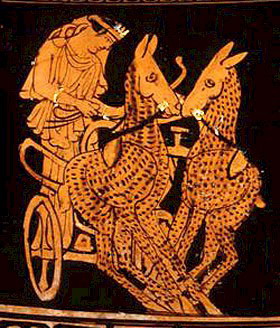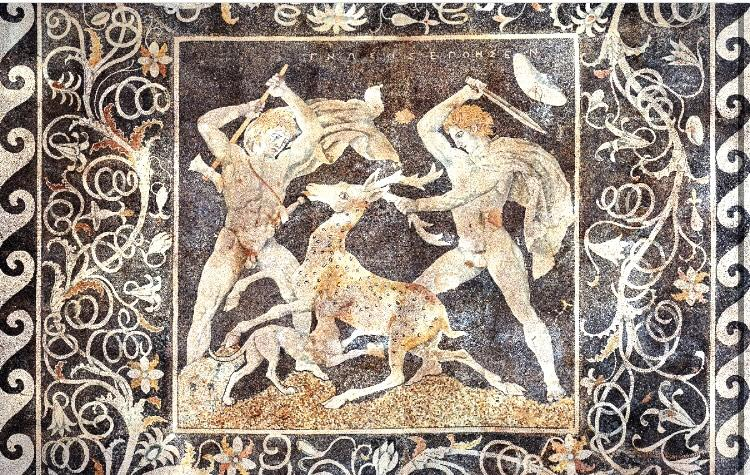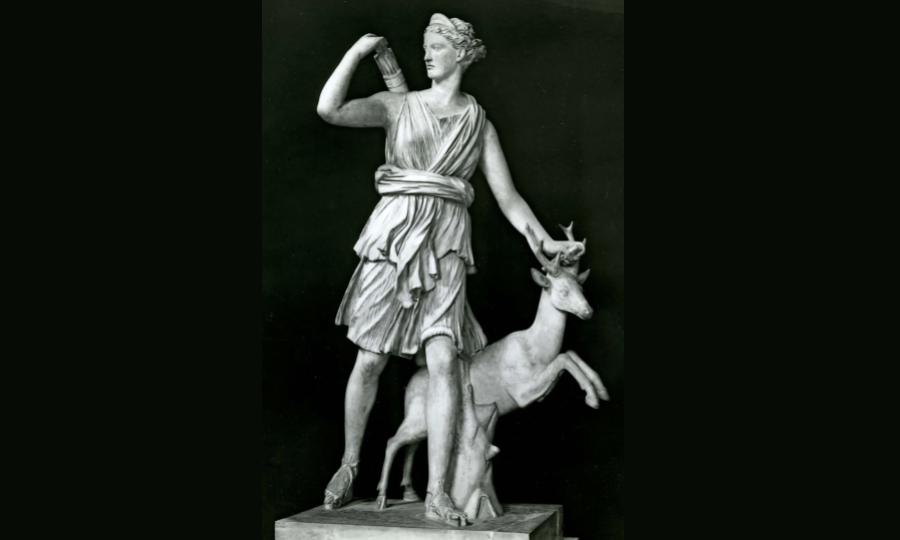If you can’t get the deer in three shots, you shouldn’t be hunting. You are an embarrassment. —— Joe Biden
Diana and her deers
Roman Moon deity Diana is also the goddess of wilderness. It may seem contradictory that she protects wildlife and at the same time is a skilled huntress. We have noticed something similar with Mielikki, the Finnish forest goddess who acts like a mother to the wounded animals but is also the Power men rely upon for a successful hunt. Both goddesses love all living beings but understand the harsh laws of nature. In ancient times, hunting and killing were necessary activities.
The deer is the animal most associated with Diana (or her Greek equivalent Artemis). But she has an ambivalent relation to these animals. In the opening lines of Seneca’s tragedy Phaedra, Diana is shown hunting tigers, lions, bisons, boars but also bucks and deers. On the other hand, in ancient pictures or statues, she is often escorted by a tamed deer, male or female. Her chariot is drawn by sacred deers. There are at least three stories which involve Diana and deers and which will highlight these contradictions.


The third labor of Hercules
The twelve labors were a series of tasks carried out by hero Hercules for the service of King Eurystheus. His third mission was to capture the deer of Cerynia that had golden horns and bronze hoofs. It was one of Diana’s sacred deers and could not be killed or hurt. Hercules pursued the animal a whole year before capturing it. On his way back, he met a very angry Diana but he explained the situation and she allowed him to finish his task, providing he released the deer afterwards.

The sacrifice of Iphigenia
The Greeks wanted to launch an expedition against Troy but the winds wouldn’t blow and their vessels were stranded in the port of Aulis. The priest Calchas revealed that Diana was angry because Agamemnon, the chief of the expedition had accidentally killed one of her sacred deers and the winds would blow again only if he sacrificed his favorite daughter Iphigenia. According to Euripides in his Greek tragedy Iphigenia at Aulis, Agamemnon was heartbroken but agreed to the sacrifice for the collective good and Iphigenia submitted to her father’s will. However, just as the father was about to strike, Diana replaced the maiden by a deer and took her to the heavens to live with the gods. So at first, Diana was angry about the death of one of her cherished deers and wanted a human sacrifice in expiation. She was moved by the fact Agamemnon was willing to sacrifice what was most dear to him so in turn she relented and agreed to give up what was most dear to her.

Actaeon or the call of the wild
Actaeon was a young hunter who fell upon Diana bathing naked in a pond with her companions. The furious goddess changed him into a stag which led him to be attacked and killed by his own dogs. We shall examine this story more closely. Hunting was a popular activity for young men in Ancient Greece and it was considered a good military training, promoting strength, courage and speed. It was a ritualized activity that obeyed strict rules. However Latin poet Ovid tells us in his Metamorphoses that Actaeon and his companions had hunted all morning and shed a lot of blood.

Actaeon was unable to stop and left his companions to wander alone in the forests. This was a mistake. Being alone in the wilderness, Actaeon loses all ties with companionship and civilization. Greek and Roman mythology are full of the tragic stories of solitary hunters such as Narcissus, Adonis or Meleager. The call of the wild is the first step to losing your identity and your life. Actaeon is changed into a speechless animal and his own dogs don’t recognize him.

The huntress and the fool
Guilty or not guilty? In his version of the myth, Ovid makes it clear that Actaeon did not want to spy on the goddess. It was an accident: «if you look carefully,you will find that it was the fault of chance and not wickedness. What wickedness is there in error?». Actaeon is a victim: «so the fates would have it». The punishment seems therefore cruel and even unfair. Greek and Roman had elaborate judicial systems and they made the difference between an involuntary act and a premeditated crime involving intention and responsibility. The accused was entitled to a trial and fair judgment.
We have to change our perspective. Actaeon’s punishment is grounded in an archaic conception of justice based on unwritten divine laws. Actaeon did not want to see Diana naked but he did and thus he committed a sacrilegious offense. That makes him an impure, cursed creature that has to be killed or expelled from the human community. His act can only be cleansed by sacrifice and expiatory rites. If we go back to Ovid’s poem, we see that he has transgressed several boundaries. First of all, he has wandered into a «sacred grove». «There was a valley…sacred to Diana». Actaeon has no right to be there. Ovid stresses the beauty of the landscape: «a wooded cave not fashioned by art». Diana is a nature goddess but she cherishes above all nature unsullied by humans and their activities. A virgin nature is what suits a virgin goddess. Ovid stresses the analogy : «she would bathe her virgin limbs in the crystal water». Actaeon defiles by his mere presence the purity of the place. His second sacrilege is of course to have seen Diana naked. He doesn’t respect the boundaries between humans and gods. He has seen what a mortal is not allowed to see. Because he has seen what only gods are allowed to see, he loses his human form and by a cruel irony the hunter becomes the prey.
Forbidden knowledge
Existentialist philosopher Jean-Paul Sartre names intellectual curiosity the Actaeon complex. The scientist is like a hunter who can sometimes be too arrogant in his quest for knowledge. The theme of misguided intellectual curiosity appears in the novel of Apuleius. Lucius, the hero, is a foolish young man who is fascinated by magic and witchcraft. But through his clumsiness he only manages to change himself into an ass – hence the double title of the novel : The Metamorphoses or the Golden Ass. He will have to overcome many hardships before being saved by Egyptian goddess Isis (her cult was becoming increasingly popular in the late Roman Empire). In the beginning of the novel – he is still a human- he is a guest of Byrrhena. In her courtyard he sees a wonderful group of marble statues representing Actaeon, Diana and the dogs. Lucius takes great pleasure in admiring the statues but it is an aesthetic pleasure. Through the skill of the artist, the stone statues seem to come alive : «the statue of Diana is running towards you». You could almost hear the dogs bark. «It is art emulating nature in a work resembling reality». Of course it is an illusion, the eye is deceived by what looks like reality. Byrrhena tries to point out to Lucius the real meaning of the sculptures. She suggests the similarity between Lucius and Actaeon. Both are victims of curiosity and this should be a warning for Lucius. But the hero will spy on a witch, see things he shouldn’t see and doesn’t understand and like Actaeon, he will be punished by losing his humanity. The episode foreshadows his fate.
But let’s not forget it’s a story about naked ladies! Some versions of the myth are more brutal and feature a more guilty Actaeon. According to Hyginus: «he saw Diana bathing and desired to rape her». To see is to desire, to desire is to want to conquer and possess. Diana becomes a mere sexual object under what feminists have called the male gaze. According to a recent definition, «essentially the male gaze sees the female body as something for the heterosexual male (or patriarchal society as a whole) to watch, conquer and possess and use for further goals». But Actaeon was no match for Diana.
Ancient representations seem to focus on the punishment scene. When Diana appears, she is fully clothed and often holds her bow and arrows. In one Instance she is even riding her chariot.


The bathing of Diana became a favorite scene in Renaissance art which showed a renewed interest for Greek and Roman mythology and an admiration for the harmony and beauty of the naked human body. Diana bathing in a beautiful setting was a challenge for artists who could show her companions in different attitudes and postures.

The theme continued to be popular in further centuries. The link will give you access to a presentation of some of these paintings.
In some circles, Diana has become a feminist icon, a figure of female empowerment and self-reliance. The story of Actaeon fits this pattern.
As goddess of animals and wilderness, Diana has also inspired environmental conservancy programs in which the goddess is viewed as an example of a woman exercising her power by caring for the planet. However we must not forget that in mythology the wilderness is by definition a cruel place marked by blood and sacrifice. Actaeon ends up paying dearly/deerly his wanderings in the wild.
Sources: https://www.persee.fr
For those interested by the general symbolic meanings of the deer: https://archive.org (Article «cerf»)
Image Source: wikimedia.org, m.musee-aquitaine-bordeaux.fr, 1oeuvre-1histoire.com, media.britishmuseum.org, lh3.googleusercontent.com, photo.rmn.fr, artsandculture.google.com.
